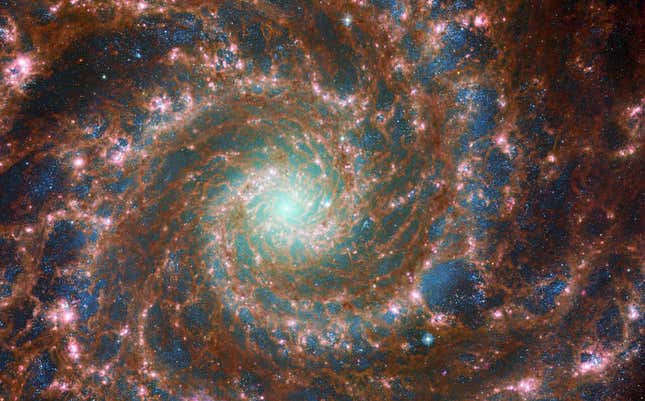
Webb’s latest image release is a special collab with the Hubble Space Telescope. Scientists combined data from the two observatories to produce these spectacular shots of the spiral Phantom Galaxy (also known as Messier 74), about 32 million light-years from Earth.
The images capture gas clouds, dust, and star-forming regions in the galaxy in sharp relief. You can even view the distant cosmos beyond the galaxy’s rust-red arms, as seen in optical and mid-infrared light
According to the Guardian, Messier 74 is nicknamed the Phantom Galaxy for how faint it is, which makes it difficult to spot in the sky. Thankfully, the Webb Space Telescope, launched in December and commissioned this spring, is the most powerful space-based observatory yet.

M74's position—nearly facing Earth head-on—and its well-articulated spiral arms make it a great target for astronomers seeking to better understand galactic evolution. The galaxy also doesn’t have much gas in its center, so the star cluster at its core is well-resolved.
M74 is just over 13 billion years old. It’s a spiral galaxy like our own Milky Way (which is a shade older). What we learn about star formation within M74 could well apply to our immediate galactic neighborhood.
Webb’s first images—of nebulae, galaxies, and spectra from an exoplanet’s atmosphere—showcased the telescope’s scientific potential. Now the telescope is being turned on a bevy of scientific targets of specific interest to various scientific collaborations. There’s even a Twitter bot that will keep you up-to-date on what Webb is observing at any given moment.
Recently, it was the CEERS collaboration’s turn to image targets with Webb, which can observe more distant and fainter targets in better resolution than other space telescopes.
The image of M74 was taken as part of work by the PHANGS collaboration, which is investigating 19 nearby star-forming galaxies to better understand how these hot balls of gas form in our nearby universe.
Looking at the galaxy in different wavelengths of light highlights different features of its structure. In images taken by Hubble in optical light, the galactic center is too bright to see much detail, but in Webb’s infrared view, you can make out individual pinpricks of light.

The Hubble image also highlights a smattering of pink splotches across the galaxy; according to an ESA release, those are hydrogen gas clouds that indicate where stars have recently formed. The merging of Hubble and Webb data makes a composite image that highlights the nuclear center of the galaxy while keeping features of its spiral arms—namely the brownish-red dust—intact.
The wavelengths elicit distinct feelings, too. The optical image makes the galaxy seem more ethereal, while the infrared image makes it look like a dreadful space whirlpool.
It’ll still be some time before the data can be sifted through by the scientific teams, who will then draw conclusions about how stars form in these nearby spiral galaxies; for now, we can just bask in the aesthetics of the cosmos.
More: New Webb Telescope Images of Jupiter Reveal the Planet’s Glimmering Auroras